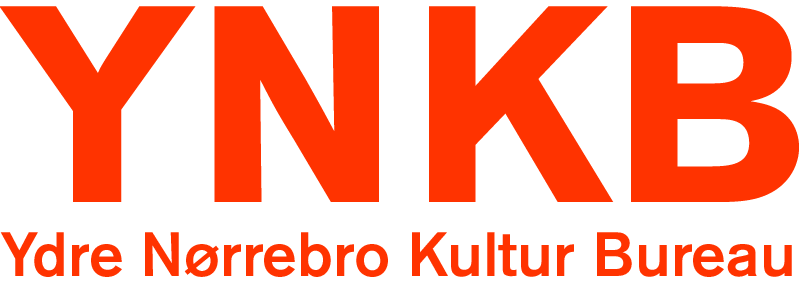July 1 – July 16 2008
step 2 in Peoples Museum, birzeit
See also Peoples Museum and Peoples Museum 1

Birzeit is a village 20 km north of Ramallah. It has been inhabited since the roman period, from which there is ruins and even before.

The name Bir Zeit literally translates to “well of oil”; referring to the wells in which its inhabitants historically stored virgin-pressed olive oil. The topology of the town consists of hills and sloping terrains with its highest point known by locals as “al-Khirbeh”, or “the ruin”. Much of the surrounding land consists of olive trees, which historically was a source of sustenance for what was primarily an agrarian society.
Today, Bir Zeit (also written as Birzeit) is a college town known for the flagship of Palestinian institutions, Birzeit University. The population of Birzeit is near 6,600 with much of its economy tied to the student population of the University. Several surrounding villages depend on Birzeit’s economy; particularly during the latest round of road closures imposed by Israel. This has led to a business expansion within the town consisting of several restaurants, cafes, Internet cafes, and salons.
(http://en.wikipedia.org/wiki/Birzeit)
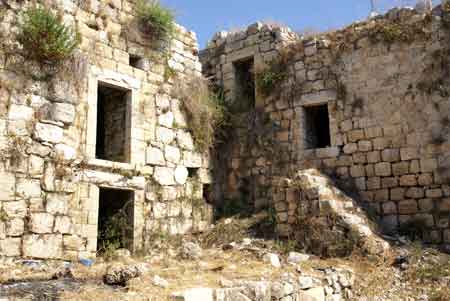
The old village of Birzeit consists of farmhouses build during the Ottoman period, (19th century) although there are building elements, taht date back to earlier periods. The traditional farmhouse is build of limestone with domes. It has two stores, the upper storey for human residents, the basement for animals.
The village of Birzeit consists of five families, – four Christians and one Muslim, but they live together without any problems. Traditionally, families have lived together with their houses grouped around a yard. This is called al-Hoash. There are several examples of them in the old village of Birzeit.
Most of the houses in the old village are empty, and many of the beautiful old houses are in ruins.
The former residents have moved into modern houses in Birzeit. The residents in the old town are mostly refugees, poor people and students from the university.
The local organization Al-Rozana is working for restoration of the old village and its revival. They are working together with RIWAQ, the Palestinian Institute for Preservation of Historical Buildings in Palestine. A few of the old houses are already restored.
Birzeit Heritage Week

Birzeit Heritage Week, July 13-19, 2008, is an annual Festival to revitalize the old village and is organized by Al-Rozana, a local organisation for revitalizing the old town. There are all kinds of activities, old handcrafts, art, performances, singing, cinema, exhibitions, and dances. This year Birzeit Heritage Week was attended by 20.000 visitors.
Presentation of Peoples Museum

Peoples Museum took part in the Heritage Festival in order to present the idea of the Peoples Museum to the citizens of Birzeit, to make contacts with the citizens and in this way create interest for the project.
In preparing our presentation we worked together with students from IAAC, Palestinian artists Majdi Hadid and Hoshi Radwan, students from the local Latin School, and the local pharmacist Moussa Alloush, who also is a local historian. We also received great and enthusiastic help from Peoples Museum’s neighbours.
For the Birzeit Heritage week Peoples Museum presented:
Model of the village
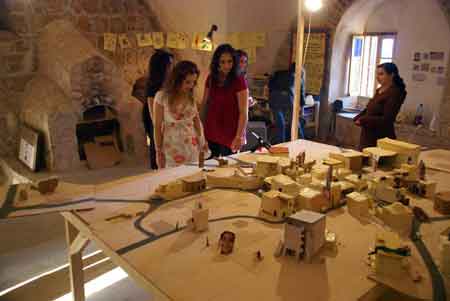
To engage people in the project, we decided to build a model of the old village in reused cardboard. The model was not finished during our stay, but while there, we concentrated on the areas closest to the Peoples Museum and houses of those we had contact with.
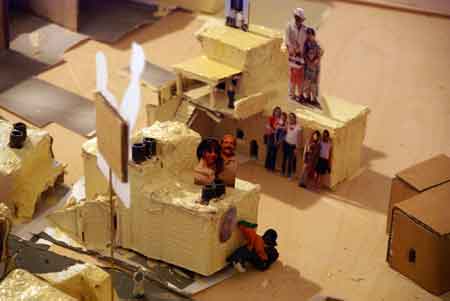
The houses were applied with photos of the residents and other details.
The audience showed great interest in the model, and people came and told stories about the houses that they have lived in.
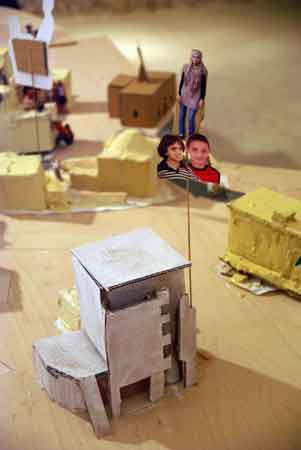
The House of Salameh Kaileh
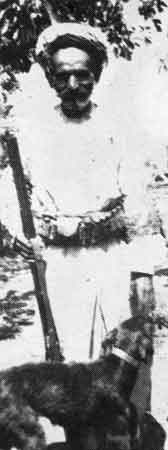
The House of Salameh Kaileh
People’s Museum is installed in the al-Kailed House, named after Salameh Kaileh.
The story of the house was written in Arabic and English and together with a photo of Salameh Kaileh from 1931, placed on a panel in the entrance of People’s Museum.
Photos

Students from the Art Academy, Reema Tamil and Avatef Romeigh presented photographic work. Reema Tamil showed 2 photo collages with photos from the old village, with signs and advertisements from Ramallah added on. Avatef Romeigh showed photos of the inscription and signs above the doors in the old city.
Haneen Masri and Kirsten showed a panel with photos of artefacts and details from people’s homes.
Watercolour workshop

The Palestinian artist, Hosni Radwan made a watercolour workshop in the old village for art students. The watercolours were presented in People’s museum during the heritage week.

The Palestinian artist Hosni Radwan made several works out of found objects from the old city for People’s Museum.
Peoples Museum Collection

On a shelf, the Beginning of the Collection was displayed, with items and books given to People’s Museum by residents.

Among them rare and special pieces, which all together created the beginning of the story of the site and the people: archaeological objects found on “al-Khirbeh”, farmers tools and objects from the households, books and pictures with relevance to the village.
Cinema
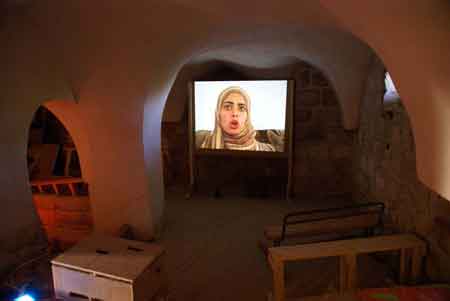
A cinema was installed in the cellar.
The program consisted of video interviews with local citizens made by Art Academy student Haneen Masri, together with YNKB/Parfyme.
These stories will be written down in Arabic and English for the peoples Museum Archive.
.
Children’s corner
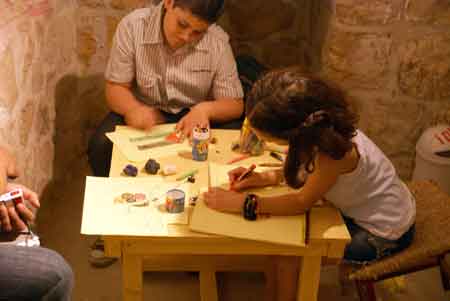
Paper and colours were on a little table in the corner for children and others. The drawings made were displayed.
Construction and reparations

The work of constructing chairs, shelves and signs and repairing windows and doors
was done by neighbours, students, Hosni Radwan, Parfyme and YNKB.
New signs
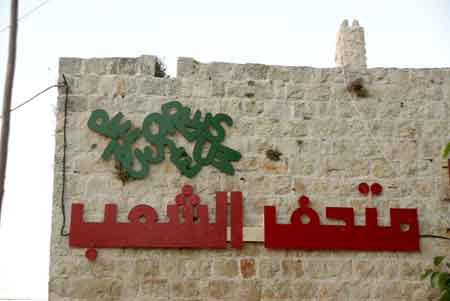
New signs for People’s Museum were cut out in plywood and were in English and Arabic.

To announce the presentation of The Peoples Museum at the festival, a student from the Latin school, Yaliano, made arrows, which she placed at different points in the old town to guide visitors to the People’s Museum
Watch Tower
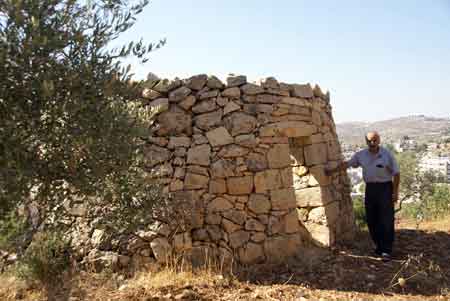
Palestinian farmers made watchtowers on their olive and grape fields. They lived in the towers during the summer in order to take care of their fields. The towers was build of limestone without using cement and mortar. Only the exact placement of every single stone according to its shape held the towers together. This tower was build by Moussa Alloush’s father, Ibrahim Alloush, 90 years ago.
